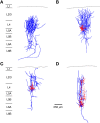Excitatory neuronal connectivity in the barrel cortex
- PMID: 22798946
- PMCID: PMC3394394
- DOI: 10.3389/fnana.2012.00024
Excitatory neuronal connectivity in the barrel cortex
Abstract
Neocortical areas are believed to be organized into vertical modules, the cortical columns, and the horizontal layers 1-6. In the somatosensory barrel cortex these columns are defined by the readily discernible barrel structure in layer 4. Information processing in the neocortex occurs along vertical and horizontal axes, thereby linking individual barrel-related columns via axons running through the different cortical layers of the barrel cortex. Long-range signaling occurs within the neocortical layers but also through axons projecting through the white matter to other neocortical areas and subcortical brain regions. Because of the ease of identification of barrel-related columns, the rodent barrel cortex has become a prototypical system to study the interactions between different neuronal connections within a sensory cortical area and between this area and other cortical as well subcortical regions. Such interactions will be discussed specifically for the feed-forward and feedback loops between the somatosensory and the somatomotor cortices as well as the different thalamic nuclei. In addition, recent advances concerning the morphological characteristics of excitatory neurons and their impact on the synaptic connectivity patterns and signaling properties of neuronal microcircuits in the whisker-related somatosensory cortex will be reviewed. In this context, their relationship between the structural properties of barrel-related columns and their function as a module in vertical synaptic signaling in the whisker-related cortical areas will be discussed.
Keywords: barrel cortex; cortical column; excitatory connections; long-range collaterals; pyramidal cell; somatosensory cortex; spiny stellate cell.
Figures







Similar articles
-
Excitatory signal flow and connectivity in a cortical column: focus on barrel cortex.Brain Struct Funct. 2007 Jul;212(1):3-17. doi: 10.1007/s00429-007-0144-2. Epub 2007 Jun 1. Brain Struct Funct. 2007. PMID: 17717695 Review.
-
Mapping functional connectivity in barrel-related columns reveals layer- and cell type-specific microcircuits.Brain Struct Funct. 2007 Sep;212(2):107-19. doi: 10.1007/s00429-007-0147-z. Epub 2007 Jun 26. Brain Struct Funct. 2007. PMID: 17717691 Review.
-
Long-range connectivity of mouse primary somatosensory barrel cortex.Eur J Neurosci. 2010 Jun;31(12):2221-33. doi: 10.1111/j.1460-9568.2010.07264.x. Epub 2010 Jun 9. Eur J Neurosci. 2010. PMID: 20550566 Review.
-
The excitatory neuronal network of the C2 barrel column in mouse primary somatosensory cortex.Neuron. 2009 Jan 29;61(2):301-16. doi: 10.1016/j.neuron.2008.12.020. Neuron. 2009. PMID: 19186171
-
Columnar organization of dendrites and axons of single and synaptically coupled excitatory spiny neurons in layer 4 of the rat barrel cortex.J Neurosci. 2000 Jul 15;20(14):5300-11. doi: 10.1523/JNEUROSCI.20-14-05300.2000. J Neurosci. 2000. PMID: 10884314 Free PMC article.
Cited by
-
Circuit-Specific Plasticity of Callosal Inputs Underlies Cortical Takeover.J Neurosci. 2020 Sep 30;40(40):7714-7723. doi: 10.1523/JNEUROSCI.1056-20.2020. Epub 2020 Sep 10. J Neurosci. 2020. PMID: 32913109 Free PMC article.
-
Circuit organization of the excitatory sensorimotor loop through hand/forelimb S1 and M1.Elife. 2021 Apr 14;10:e66836. doi: 10.7554/eLife.66836. Elife. 2021. PMID: 33851917 Free PMC article.
-
Adenosine Differentially Modulates Synaptic Transmission of Excitatory and Inhibitory Microcircuits in Layer 4 of Rat Barrel Cortex.Cereb Cortex. 2017 Sep 1;27(9):4411-4422. doi: 10.1093/cercor/bhw243. Cereb Cortex. 2017. PMID: 27522071 Free PMC article.
-
A gradual depth-dependent change in connectivity features of supragranular pyramidal cells in rat barrel cortex.Brain Struct Funct. 2015;220(3):1317-37. doi: 10.1007/s00429-014-0726-8. Epub 2014 Feb 26. Brain Struct Funct. 2015. PMID: 24569853 Free PMC article.
-
Local Connections of Pyramidal Neurons to Parvalbumin-Producing Interneurons in Motor-Associated Cortical Areas of Mice.eNeuro. 2022 Feb 2;9(1):ENEURO.0567-20.2021. doi: 10.1523/ENEURO.0567-20.2021. Print 2022 Jan-Feb. eNeuro. 2022. PMID: 34965927 Free PMC article.
References
-
- Ahissar E., Staiger J. F. (2010). S1 laminar specialization. Scholarpedia 5, 7457
LinkOut - more resources
Full Text Sources

